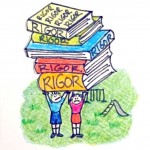The scene is set in a bedroom, full of clothing piles and random children’s toys scattered around the room. It is nighttime, and one light is on, leaving the room with a dark quiet feeling. Husband, Matt, is laying down in bed reading a book.
Wife, Caitlin, frantically enters the room like a ball of fury with her hair disheveled.
Caitlin: [shouting] “I need you to promise me something.”
Matt: [completely unphased at this random outburst] “Okay, what?”
Caitlin: [still shouting; thinking about earlier today when she was subbing kindergarten and had 3 children scream crying at the same time, directly in her face] “We are NOT going to send our son to kindergarten early!”
Matt: [still unphased] “Okay, sounds good.”
Caitlin: [visibly relieved; knowing that her son would not (read: better not) do this to a teacher one day] “Okay, thanks.”
[End scene]
Kindergarten teachers are an extra special breed. They take tiny wild humans, some of whom have never been away from their parents a day in their lives, and turn them into students. It takes a lot of heart, along with blood, sweat, and tears to do this; yet, kindergarten teachers do this with a smile knowing this is just what five-year-old children are like at the beginning of the year.
Except for this year, half of them are four.
There has always been a cut-off, where if your child was born by a certain date they were able to start the year in kindergarten. Usually, the guideline is “if your child is five years old on or before September 1st, he or she is eligible to be enrolled in kindergarten”. The students who started their kindergarten year at 4 might have a little bit of a rougher transition, depending on their preschool experience, but would generally adapt to the demands of kindergarten as the year would progress.
This year, some schools or districts are choosing to offer early entrance to kindergarten for children whose birthday falls between September 1st – December 31st. According to the Arizona Department of Education, “There is not a standardized placement exam for early kindergarten entry. The school or charter will develop their own policies and procedures to determine early kindergarten enrollment eligibility.”
Enter the 4.8 Screeners.
In the district I work for, 4.8 screeners have been created to determine early kindergarten enrollment eligibility for students who are between four years and 8 months of age and age five. The screener includes things such as sitting on the floor and listening to a story with other children and identifying some letters.
Things that my 3.5-year-old son, who is in absolutely no way ready for kindergarten, can do.
Kindergarten in 2022 is demanding. Some five-year-olds and not ready for it, and the children to enroll in kindergarten at 4 years 8 months are really not ready for it. In kindergarten, students are expected to use the restroom independently, open all the containers in their lunch independently, solve problems with their friends nicely, and learn how to read. Yes, learning how to read in Kindergarten, and the expectation to read decodable books by the end of the year.
What does learning how to read in Kindergarten look like?
K.RF.3.a Demonstrate basic knowledge of one-to-one letter correspondence by producing the primary or most frequent sounds for each consonant and the five major vowels.
Essentially, this means knowing the letter names and sounds. Complex consonants, such as how the letter “c” can say the /s/ sound, like in the word “city” are not taught in kindergarten.
K.RF.3.b Decode regularly spelled closed-syllable words.
Decode means read, and this includes words like cat, bat, sat, rat, mat, pat, etc.
K.RF.3.c Read 50 common high-frequency words by sight from a research-based word list.
This is another example of words kindergarteners read, although these are not “regular” words, such as “the”.
K.RF.3.d Distinguish the difference between similarly spelled words by identifying the sounds of the letters that differ.
This is another example, and could include finding the difference between “bat” and “cat”, or “sat” and “sit”.
To adults who have been reading for many years, these standards sound simple. However, to the four-year-old kindergartener who has never been to preschool or away from their parents, these standards are extremely challenging. It breaks my heart to think that children this young are having a poor first experience with school, simply because they are not truly ready for school. I wonder if these young students would have been the leaders in kindergarten had early enrollment in kindergarten not occurred.
I do not know the motivations of families sending their children to kindergarten early, and I am sure some families may not have had other options. I highly encourage enrolling children in kindergarten when they are socially and emotionally ready for it, regardless if your child has passed an early enrollment screener. We do not yet know what the long-term results of sending children this young to kindergarten will be, and I sincerely hope that it will end up being positive, but I shudder to think of what it would mean ten years from now if we realize this was a huge mistake.
For more information about Kindergarten in Arizona, click here.
Photo by Yan Krukov: https://www.pexels.com/photo/woman-reading-a-book-to-the-children-8613089/









